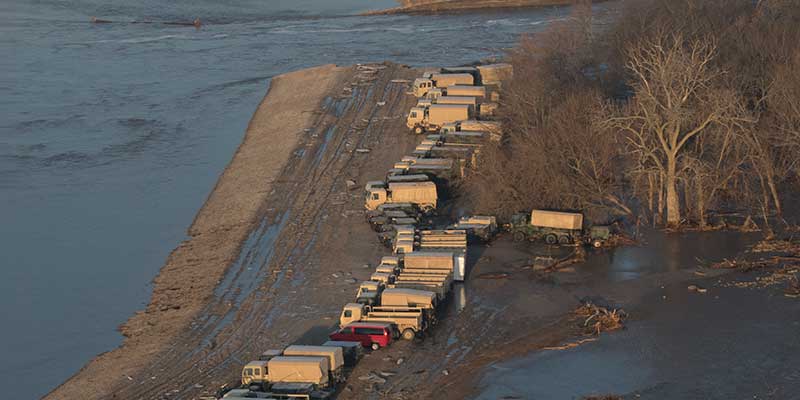Platte River waters flood Camp Ashland, Nebraska, on March 17, 2019, after a levee breach. Extensive Midwestern flooding has endangered thousands of private wells.
CDC warns of potential public health problems due to contamination
In the United States, the winter of 2018-19 has been wet. In fact, the National Oceanic and Atmospheric Administration (NOAA) reported it as the wettest winter on record, with .02 inches more total precipitation than even the winter of 1997-98.
The West, which has been suffering from extended droughts, was wetter than usual. A higher-than-average snowpack in California should give depleted aquifers some relief.
It was even wetter in the Plains states, the Great Lakes region, the southern Appalachian Mountains, and the Mississippi, Ohio, and Tennessee river valleys. But this winter’s much-needed precipitation could lead to spring flooding in California and by mid-March had already submerged wide swaths of Nebraska and Iowa, killing three and causing an estimated $3 billion in flood damage.
On March 21, Mike Parson, the governor of Missouri, declared a state of emergency due to deteriorating conditions on the Missouri and Mississippi Rivers from upstream reservoir releases, melting snow, and high rainfall levels. Missouri’s northwest corner, which borders on Nebraska and Iowa, was conducting major mandatory evacuations by March 22. The risk of flooding is expected to continue well into spring.
Water Well Contamination
Experts are warning that when the stagnating floodwaters finally subside, many private water wells may be contaminated. Steve May, assistant chief of the Missiouri Bureau of Environmental Epidemiology, put it simply: “Whatever was on land is in the water now.”
That includes sewage from overwhelmed treatment plants, animal fecal matter, pesticides, and petroleum residues. The Centers for Disease Control and Prevention warns that bacterial and chemical contamination from those sources could create a public health problem, with babies, children, pregnant women, the elderly, and those with weakened immune systems at elevated risk of gastrointestinal sickness, reproductive issues, and neurological disorders.
In the aftermath of recent hurricanes in the Southeastern U.S., agricultural waste and leaking private septic systems proved to be major sources of contamination that compromised 731,000 private wells. Bacteria can contaminate private wells through cracks or gaps common in older wells, or by seepage into groundwater. Wellheads can also be damaged by floating debris, allowing leakage of contaminated water.
The National Ground Water Association has announced there are 1.1 million wells across 300 flooded Midwestern counties in Iowa, Nebraska, Missouri, Kansas, Illinois, Indiana, Wisconsin, Minnesota, South Dakota, and Kentucky. Wisconsin will be the most affected, with 280,000 wells at risk.
A Rural Problem
Liesa Lehmann, private-water section chief for the Wisconsin Department of Natural Resources, announced:
Anyone who has a private well within a flood plain area of a major river, those wells are certainly going to be vulnerable to contamination.
Approximately 15 million American households, mostly in rural areas, have no access to regulated public water systems. They generally rely on private wells unregulated by the Environmental Protection Agency, and the treatment conducted by private well-owners may not be sufficient. The Missouri State Public Health Laboratory, however, is offering free well-water testing kits for those affected by flooding.
While the EPA doesn’t regulate private wells, it does provide resources to help well owners prevent contamination, and identify and remediate contamination when it happens.

